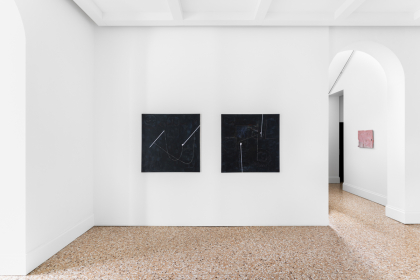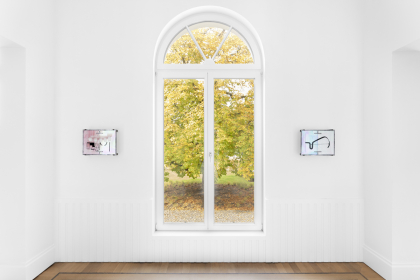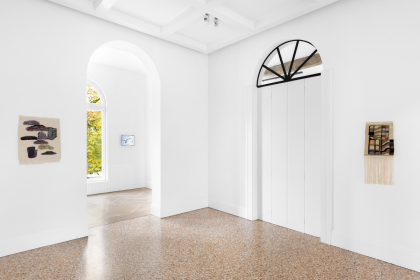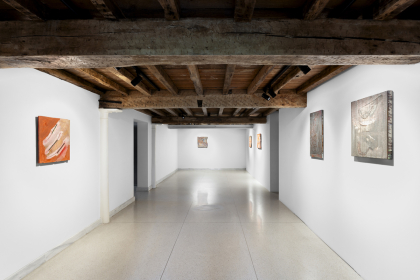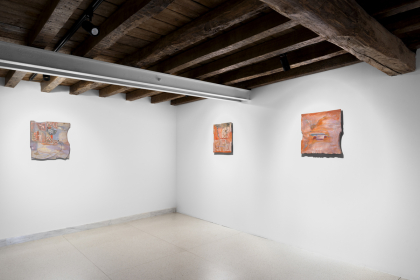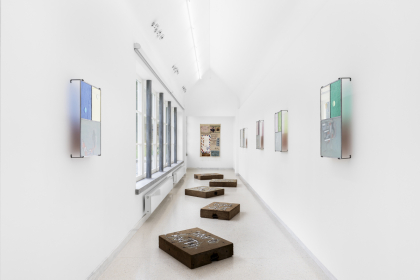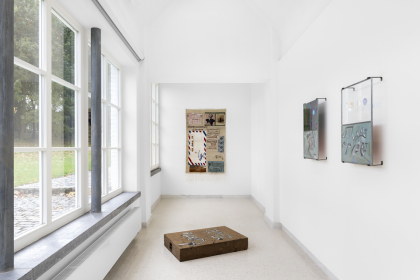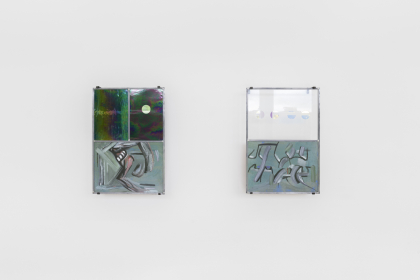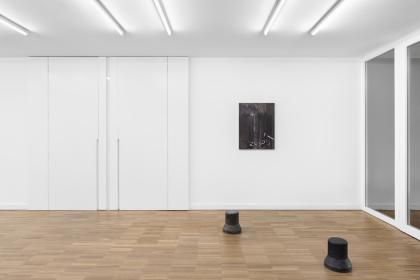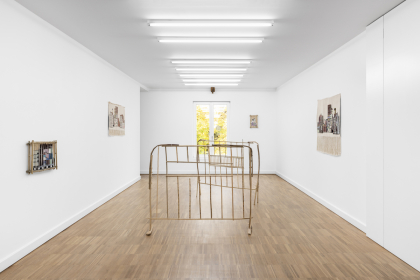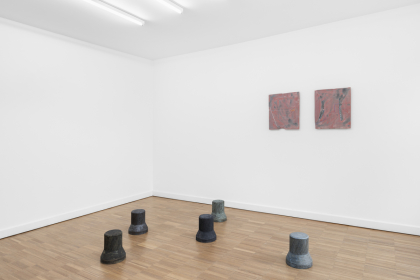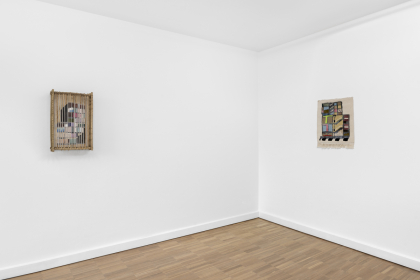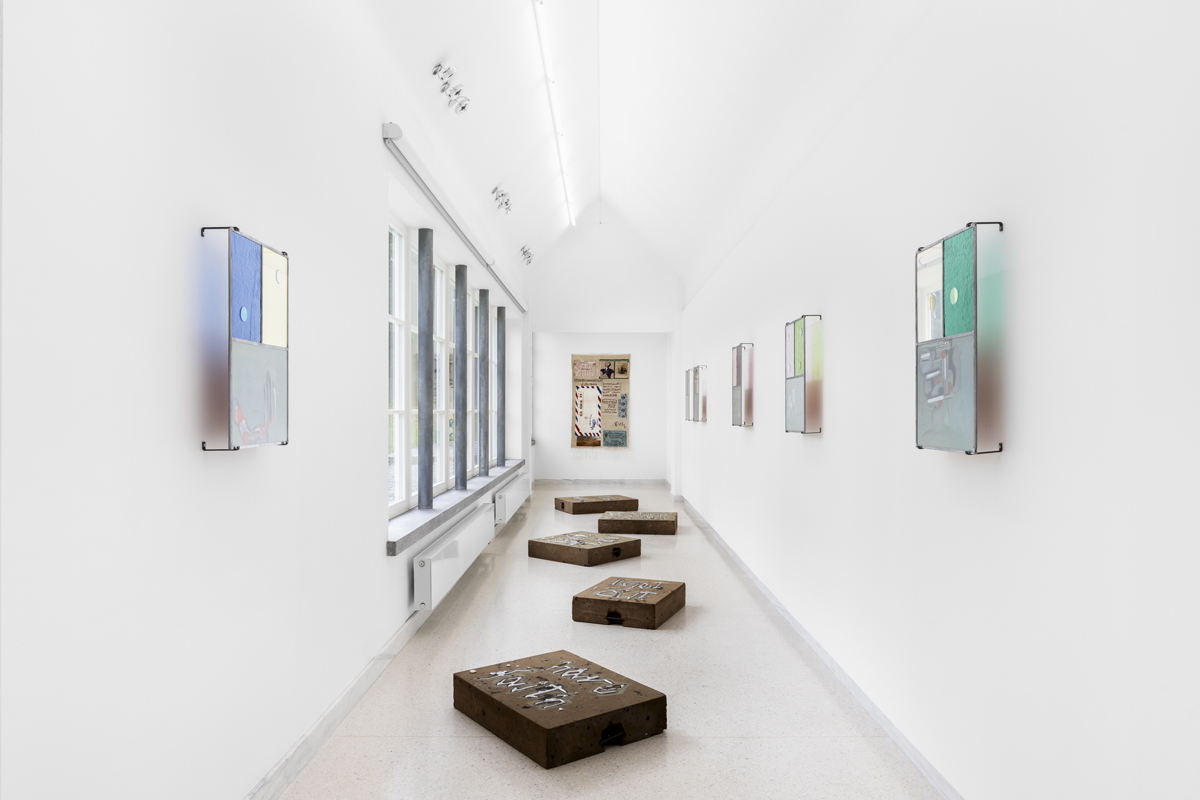
Espèces d’espaces
Stéphanie Baechler & Charlotte Eta Mumm
We confusedly experience cracks, gaps and points of friction, sometimes vaguely aware that something is stuck, that it breaks loose or collides. Though we seldom seek to learn more about it and more often than not, wander from one spot to another, from one space to another, without measuring, without taking into account or considering the course of space.
Georges Perec, “Prière d’insérer”, Espèces d’espaces, 1974
The exhibition Espèces d'espaces brings together two artists who address different types of spaces and spatiality. Stéphanie Baechler and Charlotte Eta Mumm both live and work in Amsterdam. Texture and materiality play an important role in both their practices. They both have a certain preference for clay. This is not unimportant, because although ceramics is not the most prominent discipline in this exhibition, it does inform their handling of the construction and tactility of an image. They chose the title together, after a book by Georges Perec and more specifically after his short introduction, which was intended to be inserted somewhere in the book. His text considers the concept of space concisely, but broadly: an environment in which we find ourselves, which we can observe, but which we rarely subject to deep investigation or reflection.
Stéphanie Baechler spent three months in Cairo last year, where she learned Egyptian weaving techniques during a residency from Pro Helvetia at the Wissa Wassef Art Center. She created a series of tapestries and knot carpets, but also sculptures in palm wood. Under the authoritarian regime of President Abdel Fattah el-Sisi, entire neighborhoods have to make way for the construction of new bridges and highways. Hundreds of families are ordered to leave their homes. As a result, the chaos and bustle of Cairo have been exacerbated by the presence of half-demolished buildings and associated rubble. In her small tapestries, Baechler quite literally depicts what she saw: cross-sections of houses, bisected streets, and cars covered to protect them from dust – witnesses to displacement.
The ambivalence of these images is confronting. The devastating hardness of the subject and the patient, careful and constructive weaving techniques are intertwined. Inspired by art historians such as Seth Siegelaub and Aby Warburg, Baechler likes to view her works as image vehicles. Materiality itself is a means of communication. The same goes for the palm wood fences and the paintings on palm wood, inspired by handmade boxes in which bread, fruit and vegetables are sold. The painted images refer to innocent, colorful children's rooms that are sometimes exposed in a half-destroyed building; traces of a daily and intimate life.
'As a stranger, you are blind even if you can see' – this is the expression used by an Egyptian artist and curator in the publication with which Baechler concluded her residency project. With geographical and psychological distance, it is possible to find beauty even in destruction; harsh reality becomes an autonomous image with aesthetic qualities that translate both a destroyed life and a political reality. This is not a denial, but a form of dormant hope. It bears similarities to images like The Destroyed Room by Jeff Wall: destructive, but also sublime. Tragedy, but also transformation.
I remember a teacher in high school comparing the human mind to a house: memories and feelings are in rooms, where you can leave them behind closed doors, or where you can visit them. But there are also corridors where thoughts may wander aimlessly, doors through which ideas escape or windows through which a long-lost memory blows in. And sometimes the walls seem to close in on you.
Charlotte Eta Mumm's works take place on an inner plane. Her paintings and stained-glass collages tend towards abstraction and arise from an interaction between the artist and the work itself. The framework of her canvases is often constructed from residual materials. The erratic shape forces the canvas into all kinds of tense positions, and also adds texture, shadow, and sculpturality. The stained glass allows light as an additional dimension. The impact of the partial transparency of the works and their intentional distance from the wall, as well as their play of colour, light, and shadow, depends on the space and the position of the viewer.
Whichever the material, Mumm works with paradoxes. Vacillating between blurring and recognition, the works candidly delve into the misconceptions of our communication, on an inner level (between heart and brain, between blood and organs, between mind and skin) or from an inner to an outer world. Like the glass or the skin of the canvas she works with, life also has a certain porosity. Permeable circumstances and conditions ranging from external factors to emotions help determine our perception of time – which is also a space through which we move. Different dimensions, stories and experiences seem to counter each other but, paradoxically, exist in a parallel flow.
Any artwork does not consist of only one, two or three dimensions. A work of art is a metaverse in itself. A work of art is a physical presence that adapts depending on the context and space, but also the viewer. The viewer's body enters into a relationship with the physical characteristics of the work and thus indirectly with the artist. Each viewer also has a unique relationship with each work. It is subject to conditions such as scale, mood, background, light, time and of course space. By definition, the architectural context in which we move has an enormous impact on our (sensory and energetic) perception.
In a metaphysical dimension between architecture and existence, Baechler and Mumm find their Berührungspunkt, their touching point (as in: point of contact, but from the German it could also be translated as a ‘point of being emotionally moved’). They experience cracks, gaps, points of friction; things that are stuck, break loose, or collide. As they wander from one space to another, they consider their course and their impact. Their works are not so much about architectural qualities, but about the conditions of life itself: the environment where we are safe, where we can shelter, where we can be ourselves, the space that we are allowed to occupy and furnish, the space that others can take from us. A space of certainty, but also: allowing some space for openness, ambivalence, fluidity, transformation.
Tamara Beheydt

